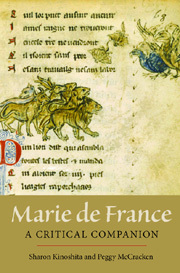Book contents
- Frontmatter
- Contents
- Preface
- Note on Editions
- 1 Introduction: the World of Marie de France
- 2 Communication, Transmission, and Interpretation: Literary History
- 3 Courtly Love and Feudal Society: Historical Context
- 4 Movement and Mobility: Plot
- 5 Bodies and Embodiment: Characters
- 6 Repetition and the Art of Variation: Narrative Techniques
- 7 Posterity: The Afterlives of Marie's Works
- Further Reading
- Index
- Already Published
3 - Courtly Love and Feudal Society: Historical Context
Published online by Cambridge University Press: 12 September 2012
- Frontmatter
- Contents
- Preface
- Note on Editions
- 1 Introduction: the World of Marie de France
- 2 Communication, Transmission, and Interpretation: Literary History
- 3 Courtly Love and Feudal Society: Historical Context
- 4 Movement and Mobility: Plot
- 5 Bodies and Embodiment: Characters
- 6 Repetition and the Art of Variation: Narrative Techniques
- 7 Posterity: The Afterlives of Marie's Works
- Further Reading
- Index
- Already Published
Summary
Vernacular literature, writes the historian Georges Duby, was one of the forms “forged to assert the independence of a culture, that of warriors, which was arrogant and, in its enjoyment of life, was resolutely opposed to the culture of the priests.” Against a view of medieval society as a seamless whole – a view that assumes the consonance between religious and secular society and thus predisposes us to expect learnéd culture to influence the vernacular culture of its day – Duby invites us to consider concerns like marriage and adultery, chivalry, honor, and good lordship, specific to the secular nobility and especially liable to run afoul of ecclesiastical regulation. In this chapter we turn to Marie de France's engagement with twelfth-century historical institutions as she imagines feudal relations in all their variations and permutations. Her representations range from the critical to the ideal, shaping not only the world of knights, ladies, and kings but also the animal world and life in the hereafter.
The Lais
The world of the Lais is resolutely secular. Even tales with the most strikingly otherworldly elements are set in feudal principalities or kingdoms wracked by wars or playing host to contests of chivalric honor, where erotic love is frequently expressed through a vocabulary of fief-holding. Guigemar first appears as the son of a vassal of the king of Lesser Brittany in those ancient times when Hoël “ruled the land” (tint…la terre, Guigemar, l. 27).
- Type
- Chapter
- Information
- Marie de FranceA Critical Companion, pp. 51 - 112Publisher: Boydell & BrewerPrint publication year: 2012

